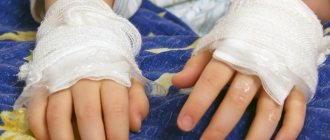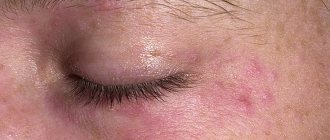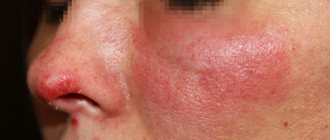Last update: 02/21/2021
Photodermatitis or sun allergy is a specific reaction of the skin to ultraviolet rays falling on it. This sensitivity most often occurs in people with very fair skin, belonging to the so-called Scandinavian type of appearance, but it also occurs in other cases. Symptoms and treatment for dermatitis may vary in each individual case of the disease.
Sun allergy: what is it?
There is no need to think that the allergen that causes inflammation is the sun's rays themselves. The mechanism of the disease is somewhat more complicated. Increased susceptibility to ultraviolet radiation is caused by the presence in the patient’s body of sun-sensitive substances - photosensitizers. The interaction of their radicals with skin protein leads to inflammation.
In addition, not only solar dermatitis occurs, but also a violent reaction of the body to artificial tanning. By the way, frequent visits to the solarium can provoke an allergy to the sun's rays.
Types and photos of photodermatitis
Three types of response of human skin to ultraviolet rays of natural and artificial origin can be noted:
- Phototraumatic reactions. These are inflammations not associated with allergies. In other words, these are burns that appear from prolonged exposure to the sun or in a solarium booth. Anyone can have a similar reaction.
- Phototoxic reactions. This is a reaction to rays provoked by the consumption of foods containing photosensitizers. This type of allergy can occur even in a healthy person.
- Photoallergic reactions. They arise as a result of pathological rejection of sunlight by the body. Such a reaction is precisely a typical manifestation of a disease such as photodermatosis.
Complications of allergic contact dermatitis
The most dangerous acute allergic reaction occurs when a large amount of allergen enters the body. This can lead to shock, anaphylaxis, and angioedema. These reactions involve the B cells of the immune system and are called immediate reactions. They are not directly associated with dermatitis, but they occur more often in people with abnormalities in the immune system than in healthy people.
Contact dermatitis can lead to the following complications:
- The addition of a secondary infection, when fungi and bacteria penetrate the skin when scratching. This can cause chronic inflammation of the skin, hair follicles, and glands. Purulent foci form, which are very painful, itchy, and cause anxiety.
- Weeping erosions, cracks, crusts that are torn off due to itching can leave behind unattractive scars, areas of pigmentation, thickening of the skin or, conversely, atrophy.
Similar complications are observed in atopic disease.
Photodermatitis: causes
Sun allergies can be caused by external or internal causes. In the first case, there is an exogenous type of disease, and in the second, an endogenous type of disease.
The following means and substances can contribute to the appearance of photodermatitis from the outside:
- Household chemicals. Some household cleaning or clothing care products contain photosensitizers in the skin.
- Personal hygiene products (soaps, creams and other cosmetic products based on natural oils of sea buckthorn, dill, citrus fruits, etc.). You should also be wary of sunscreens, which, oddly enough, can provoke an atypical response to the sun's rays.
- Medicines. Before using any medications during the hot season, check with your doctor to see if they cause an adverse reaction such as an allergy to the sun.
- Sweeteners. Some food additives used instead of sugar can cause an allergic reaction to the sun.
- Substances entering the skin during tattooing. It is better to avoid getting a tattoo just before the beach season.
Exogenous photodermatitis develops against the background of disruption of certain body systems. These may be diseases and conditions such as:
- Kidney and liver diseases that reduce the effectiveness of removing toxins from the body.
- Diabetes.
- Excess weight as a consequence of metabolic disorders.
- Use of oral contraceptives.
- Hypovitaminosis.
- Pregnancy period.
Sometimes doctors are unable to determine the cause of the disease. When an allergy occurs in a healthy person, they speak of idiopathic photodermatitis. Presumably it is provoked by a special protein allergen in the patient’s skin.
Photodermatitis: symptoms
Signs of a sun allergy are often indistinguishable from the symptoms of other skin diseases, so it is necessary to see a doctor to determine the diagnosis.
Photodermatitis can manifest itself as follows:
• Skin peeling. A common symptom of the chronic form of the disease. Occurs due to a violation of the lipid membrane of the skin. • Redness. The dilation of blood vessels causes the skin to become red and swollen. This is one of the fastest-growing signs of photodermatosis. • Rashes. The rash can have different appearances: pustules, blisters, nodules, papules. • Burning and itching. As a result of swelling, the nerve endings are compressed, which leads to unpleasant sensations. The appearance of itching is promoted by scratching the rash, during which infection is introduced into the wounds. • Pigmentation. After prolonged exposure to the sun, the skin darkens (melanin or other pigment accumulates in it).
In addition, photodermatitis may be accompanied by symptoms typical of any form of allergy. These include:
- Fever.
- Decreased pressure or surges.
- Suffocation.
- Sneezing and runny nose.
- Swelling of the mucous membranes.
- Tearing.
Symptoms
The mechanism of development of the disease is toxic or allergic in nature.
In the allergic pathway, the chemical composition of a substance on/in the skin changes and it gains the ability to provoke reactions. A distinctive feature of this route is the rapid reaction and spread of symptoms, including areas protected from the sun.
With the toxic development of the disease, skin cells lose their ability to resist UV rays, and the resulting burns in the inner layers of the skin lead to severe inflammation. Some of the cells die, itching, irritation, blisters, papules, and pustules appear. The reaction only applies to those places that were not covered from the sun.
Photodermatitis has clear symptoms:
- redness and swelling of the skin;
- acquisition of a reddish tint on the lips and mucous membranes of the eyes;
- rashes of various types from blisters and nodules to papules and pustules;
- itching, which occurs due to compression of nerve endings due to swelling (scratching leads to infection);
- skin pigmentation - becomes noticeable after other symptoms disappear, due to the accumulation of melanin;
- peeling of the skin during the chronic course of the disease.
Depending on the mechanism of development, areas not covered by clothing are affected - décolleté, face, neck, hands, or inflammation spreads to covered areas. The limbs suffer less often than others. With exogenous photodermatitis, in addition to the listed skin manifestations, fever, weakness, lacrimation, pain in the eyes, nasal reactions, and swelling of the mucous membranes may occur.
The intensity of manifestations depends on skin type, level of health and immunity, and the presence of other allergies. In some patients, the condition may worsen to the point of fainting, bronchospasm and decreased blood pressure.
The listed signs are nonspecific and can easily be confused with a food allergy. For some people, a rash and redness appear within half an hour after being in an open area, for others, symptoms appear after 8-12 hours. Please note that not only the real sun has an effect, but also artificial ultraviolet radiation in a solarium.
Photodermatitis: treatment
If you find the symptoms described above in yourself or your family, you should consult a dermatologist. You may also need examinations by a hematologist, therapist, rheumatologist, or allergist.
The dermatologist will conduct a detailed survey and examination to find out how long ago the signs of the disease were detected, what preceded their appearance, and whether similar symptoms have previously occurred in you or your family members. The doctor will also ask about the medications you are taking and the hygiene products you use, cosmetics and household chemicals.
The patient is then sent for tests to definitively determine the cause of photodermatitis. This could be research such as:
Diagnostics
Treatment of photodermatitis is carried out by a dermatologist at any branch of the NEARMEDIC network. The specialist collects anamnesis and identifies:
- information about periods of exacerbation of rashes,
- relationship with medications taken, cosmetics used,
- nutritional features;
- information about exposure to chemicals and constant sun exposure at work;
- the presence of a hereditary predisposition.
The dermatologist conducts a physical examination and refers the patient for laboratory/instrumental diagnostics. To clarify the diagnosis in controversial cases, a related specialist is involved.
Doctors who help the dermatologist with diagnosis:
- therapist - identifies the relationship with medications taken;
- allergist - if there is a suspicion of a reaction to an allergen;
- rheumatologist - if there are problems with connective tissue;
- hematologist - for symptoms indicating porphyria;
- hepatologist - if hemochromatosis is possible.
Timely diagnosis makes it possible to determine the endogenous or exogenous nature of the manifestations, and thereby detect a serious disease for which photodermatosis is a symptom.
Diagnostics includes the following steps:
- allergy tests;
- blood tests;
- Analysis of urine;
- serological studies;
- rheumatic tests that identify autoimmune problems and connective tissue diseases;
- Ultrasound to determine the root cause in the form of kidney disease, liver and other organs.
Medicines prescribed for sun allergies
For severe forms of dermatitis, complex systems of medications are prescribed. In this case, the main goal is to eliminate the underlying cause of the disease.
In milder forms, it is possible to get by with ointments for dermatitis that are properly selected by a doctor.
There are several groups of drugs used in the treatment of photodermatosis:
- zinc-based ointments;
- antiseptics;
- anti-inflammatory creams;
- ointments based on Panthenol;
- antihistamines;
- drugs aimed at removing toxins from the body;
- hormonal agents.
Treatment of allergic contact dermatitis
To treat atopic and contact dermatitis, it is important to eliminate exposure to the allergen on the body. Sometimes it cannot be established even after a long examination. In this case, treatment with drugs is indicated:
- Second generation antihistamines - they inhibit the release of histamine by mast cells, reduce skin itching and other manifestations of acute allergic inflammation. Tablets are prescribed internally, and ointments with a soothing effect are prescribed locally.
- Hormonal drugs for severe contact dermatitis. They can also be used internally and externally.
- Specific desensitization is the introduction of an allergen in microdoses, in ever-increasing quantities. This helps the body change its perception of the allergen and correct pathological reactions of the immune system.
- For secondary bacterial or fungal inflammation, antibiotics and antifungal agents are added.
Therapy for atopic dermatitis is often long-term and requires persistence from parents and compliance with all doctor’s recommendations. Healthy:
- follow a hypoallergenic diet;
- monitor the regularity of bowel movements;
- avoid stress;
- use skin softeners (emollients), apply them twice a day without damaging the skin;
- for weeping erosions, ointments with zinc, dye solutions (Castellani liquid, fucorcin) are applied topically, and lotions are made with herbal decoctions (oak bark).
Clinical researches
The conducted clinical study proves the high efficiency, safety and tolerability of products for daily skin care of children and adults with mild and moderate forms of atopic dermatitis and during remission, accompanied by a decrease in the quality of life of patients. As a result of therapy, a decrease in the activity of the inflammatory process, a decrease in dryness, itching and flaking was noted.
Based on the results of joint research, the following information is placed on product packaging: “Recommended by the St. Petersburg branch of the Union of Pediatricians of Russia.”
Sources:
- Ratner Desiri, Avram M.R., Avram M.M., Procedures in Dermatology. Clinical cosmetology, GEOTAR-Media, 2022.
- Sukolin Gennady Ivanovich, Clinical dermatology. A short guide to the diagnosis and treatment of dermatoses, Notabene, 2017.
- Sukolin Gennady Ivanovich, Illustrated clinical dermatology. Brief alphabetical reference book, Lux Print publishing house, 2010.
Photos of dermatitis
Photo album on the disease










